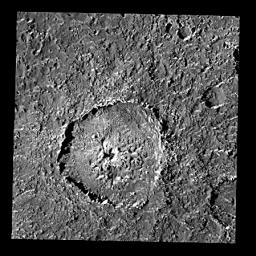This single-frame image shows crater Tindr on Jupiter's satellite Callisto, the moon with the oldest surface of the four so-called "Galilean" satellites (of which Callisto is also most distant from Jupiter). The diameter of this impact feature is about 70 km (43.5 miles). Tindris situated close to Callisto's equator at a longitude of about 5 degrees East. The image was obtained in September 1997 with the Solid State Imaging (SSI) system onboard NASA's Galileo spacecraft, which has been orbiting the Solar System's largest planet since December 1995.
Shadows are long and accentuate morphology on the surface, because the image was taken under low sun illumination. The image was captured from a distance of about 40,000 km (25,000 miles) during Galileo's 10th orbit around Jupiter. The resolution is about 390 m/pixel, the smallest features that are still discernible are about 780 m across. The sun illuminates the scene from the left. North is pointing towards the top of the image. The image covers an area approximately 150 x 150 km.
Tindr is slightly irregular in shape. This could be the consequence of an oblique impact. Along its eastern and southeastern part, the rim appears degraded; only isolated hills or hill chains are still visible. The floor shows numerous irregular pits, features that are found in some other Callistoan craters and also in Callisto's dark cratered plains. These features are believed to be caused by sublimation of subsurface volatiles. Subradial streaks outside the crater rim are due to impact debris creating secondary craters some distance away from Tindr. Continuous ejecta covers several older craters, especially in the northeastern part of the scene. The Tindr ejecta merge into surrounding cratered plains without a distinct morphologic or albedo boundary. Apparently the dark material blanketing Callisto's surface globally was emplaced after Tindr had formed.
Absolute ages derived from measured crater densities are model-dependent. In one crater chronology model, based on impacts dominated by asteroids, Tindr may be an old feature, about 3.9 billion years old, pointing back in time into a period of more intense bombardment than today. In another model, based on impacts preferentially by comets with a more or less constant impact rate, Tindr can be much younger, about 1 billion years old.
The Jet Propulsion Laboratory, Pasadena, CA manages the Galileo mission for NASA's Office of Space Science, Washington, DC.
This image and other images and data received from Galileo are posted on the World Wide Web, on the Galileo mission home page at URL http://solarsystem.nasa.gov/galileo/. Background information and educational context for the images can be found at http://www.jpl.nasa.gov/galileo/sepo.

 Planetary Data System
Planetary Data System












